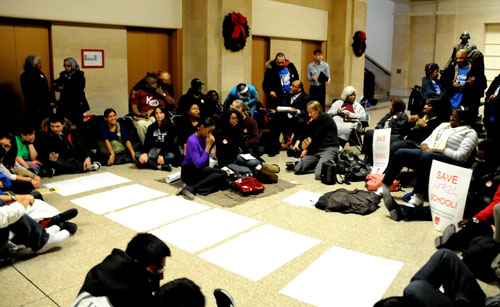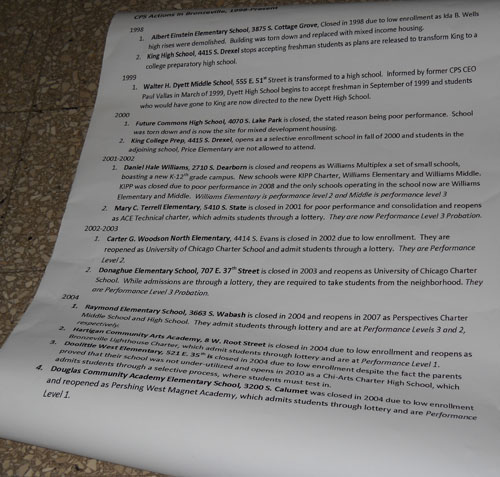Mayor, media ignore the writing on the walls (er., on the floors...)... Sit in at City Hall tells the story of more than a decade of sabotage of Bronzeville public schools
It's been there for more than two days, right on the cold marble floors of Chicago's City Hall, outside the office of what may be the most famous Mayor's Office in the USA ŌĆö Chicago's "Fifth Floor" Home of The Boss. Since the Sit-In began on Wednesday, January 4, some of the protesters have been conducting a visual teach in, with posters tracking the history of how the schools of Chicago's "Bronzeville" community were sabotaged by more than a decade of corporate "school reform."
 The messages available to anyone who wished to read them were spread on the floor at the beginning of the sit-in (white posters, above in center). The first two told the ten-year history of the sabotage of the lakefront portion of Chicago's "Bronzeville" community's schools under Paul G. Vallas, Arne Duncan, Ron Huberman, and Terry Mazany. Each of the four previous "Chief Executive Officers" of Chicago's public schools had implemented a consistent policy of school closings and privatization that was never made public, but which became clear at the decades went on. The policy eliminated the major public institutions in the community (public schools and public housing) and privatized as much as possible (see chronological posters below). Substance photo taken January 4, 2012 at the beginning of the sit-in. Substance photo by George N. Schmidt.The materials, prepared by the Kenwood Oakland Community Organization (KOCO) in Chicago, traces the attacks on the public schools of "Bronzeville" back to the late 1990s, when Paul G. Vallas was serving as the first "Chief Executive Officer" of Chicago's public schools, following the mayoral control takeover approved by the Illinois General Assembly in 1995.
The messages available to anyone who wished to read them were spread on the floor at the beginning of the sit-in (white posters, above in center). The first two told the ten-year history of the sabotage of the lakefront portion of Chicago's "Bronzeville" community's schools under Paul G. Vallas, Arne Duncan, Ron Huberman, and Terry Mazany. Each of the four previous "Chief Executive Officers" of Chicago's public schools had implemented a consistent policy of school closings and privatization that was never made public, but which became clear at the decades went on. The policy eliminated the major public institutions in the community (public schools and public housing) and privatized as much as possible (see chronological posters below). Substance photo taken January 4, 2012 at the beginning of the sit-in. Substance photo by George N. Schmidt.The materials, prepared by the Kenwood Oakland Community Organization (KOCO) in Chicago, traces the attacks on the public schools of "Bronzeville" back to the late 1990s, when Paul G. Vallas was serving as the first "Chief Executive Officer" of Chicago's public schools, following the mayoral control takeover approved by the Illinois General Assembly in 1995.
(In 1995, the Republican Illinois House and Illinois Senate approved a "bipartisan" piece of legislation ŌĆö called the Amendatory Act ŌĆö supported by then Chicago Mayor Richard M. Daley. The Amendatory Act gave Chicago's mayor dictatorial control over the city's public schools by giving him the power to appoint a "Chief Executive Officer" ŌĆö who didn't have to be a credentialed educator ŌĆö and a seven member school board. The Act also stripped many of the collective bargaining rights from the then powerful Chicago Teachers Union).
Now that the annual "Hit List" (as critics have called it) of Chicago schools slated for closing is in its tenth year (it was launched by Arne Duncan in 2002 and has been an annual attack on teachers and inner city schools ever since), it has a history, which Chicago's corporate media and reporters continue to ignore. But the story from one community is now on the floor every day the sit-in is at Chicago's City Hall.
The posters include proposals for the future, but also a key outline of the past.
 The history of the destruction of real public schools and the implementation of one of the nation's most vicious programs of privatization and gentrification using corporate "school reform" as the pretext was on display in the history prepared by KOCO during the early January sit-in at Chicago's City Hall. Above, the poster showing the outline of the attacks on public schools between 1998 and 2004 that was displayed on the floor and utilized during the teach in that was ignored by Chicago's media, both during the years the destruction was being done and as late as January 2012. Substance photo by Susan Zupan.The first historical poster showed how by 1998, when Paul G. Vallas was "Chief Executive Officer" of Chicago's public schools and Richard M. Daley was mayor, CPS began to close or radically reorganize the schools in the "Bronzeville" community, eliminating community access to a growing number of neighborhood schools, and slowly replacing many of them with charter schools. In most cases, the replacement schools were charter schools, which did not have local school councils.
The history of the destruction of real public schools and the implementation of one of the nation's most vicious programs of privatization and gentrification using corporate "school reform" as the pretext was on display in the history prepared by KOCO during the early January sit-in at Chicago's City Hall. Above, the poster showing the outline of the attacks on public schools between 1998 and 2004 that was displayed on the floor and utilized during the teach in that was ignored by Chicago's media, both during the years the destruction was being done and as late as January 2012. Substance photo by Susan Zupan.The first historical poster showed how by 1998, when Paul G. Vallas was "Chief Executive Officer" of Chicago's public schools and Richard M. Daley was mayor, CPS began to close or radically reorganize the schools in the "Bronzeville" community, eliminating community access to a growing number of neighborhood schools, and slowly replacing many of them with charter schools. In most cases, the replacement schools were charter schools, which did not have local school councils.
Corporate "school reform" dovetailed with what was called "Housing Reform." Public housing in the area (Ida B. Wells; Maddon Park Homes; Stateway Gardens) was replaced by what was supposed to be "mixed income" housing, but the majority of the former residents were eliminated forever from the community, many families broken up, and in some cases, children left homeless.
The third component of what has since been called the "neoliberal agenda" was what was called "welfare reform." Taking away what had been considered the right of children to a low but possible standard of nutrition, health, housing, and clothing, the slow elimination of welfare beginning during the Clinton administration landed hardest on the poorest families in Chicago's Bronzeville community during the final years of the 20th Century, at the same time their schools (often the central community institutions) were also being destroyed, and public schools with elected democratic local school councils replaced, most often, by charter schools with top-down autocratic models of governance.
The process began in the schools in 1998, when CPS closed Einstein Elementary School and converted King High School from a neighborhood high school to a selective enrollment "college prep" high school. At that time, Paul G. Vallas was schools CEO, Gery Chico was President of the school board, and Richard M. Daley was mayor.
In 1999, Walter H. Dyett Middle School was closed and transformed into a high school, in part because of the disruption caused by the closing of King High School. At that time, Paul G. Vallas was schools CEO, Gery Chico was President of the school board, and Richard M. Daley was mayor.
In 2000, Future Commons High School was closed. The school was in the Chicago Housing Authority projects at 39th and Lake Park. At that time, Paul G. Vallas was schools CEO, Gery Chico was President of the school board, and Richard M. Daley was mayor.
By the 2001 - 2002 school year, the process continued, with the new Chief Executive Officer, Arne Duncan, declaring that he had to begin a "renaissance" aimed at closing what he called "failing" schools. Two of the three schools he proclaimed to be "failing" were in Bronzeville ŌĆö Daniel Hale Williams (39th and Dearborn) and Mary Church Terrell (54th and State). Both were in Chicago Housing Authority housing projects that had been disrupted by CHA closings that resulted in increased gang activity (adjacent to Williams). In one sense, the "renaissance" had begun (although it would not be called "Renaissance 2010" until two years later. At that time, Arne Duncan was schools CEO, Michael Scott was President of the school board, and Richard M. Daley was mayor.
During the 2002- 2003 school year, two more Bronzeville public schools were closed, both to be given to the University of Chicago for charter schools. Carter G. Woodson (4414 S. Evans was closed, supposedly because of low enrollment) and Donoghue (707 E. 37th St.) both ended up privatized as part of the University of Chicago network of charter schools. At that time, Arne Duncan was schools CEO, Michael Scott was President of the school board, and Richard M. Daley was mayor.
By 2004, the process of destruction was accelerated by Arne Duncan and Michael Scott. Four schools in the community were closed, all for "low enrollment" as Arne Duncan proclaimed, with the support of the media, that public schools with "low enrollment" (as measured by dubious CPS measurements and claims) were too expensive for the public to sustain. By 2010, three of the four had been reopened as charter schools. At that time, Arne Duncan was schools CEO, Michael Scott was President of the school board, and Richard M. Daley was mayor.

